Castilleja
| Castilleja | |
|---|---|

| |
| Castilleja miniata | |
| Scientific classification | |
| Kingdom: | Plantae |
| Clade: | Tracheophytes |
| Clade: | Angiosperms |
| Clade: | Eudicots |
| Clade: | Asterids |
| Order: | Lamiales |
| Family: | Orobanchaceae |
| Subtribe: | Castillejinae |
| Genus: | Castilleja Mutis ex L.f. |
| Species | |
|
About 200, see text | |
| Synonyms | |
Castilleja, commonly known as paintbrush, Indian paintbrush, or prairie-fire, is a genus of about 200 species of annual and perennial herbaceous plants native to the west of the Americas from Alaska south to the Andes, northern Asia, and one species as far west as the Kola Peninsula in northwestern Russia. These plants are classified in the broomrape family Orobanchaceae (following major rearrangements of the order Lamiales starting around 2001; sources which do not follow these reclassifications may place them in the Scrophulariaceae). They are hemiparasitic on the roots of grasses and forbs. The generic name honors Spanish botanist Domingo Castillejo.[2]
Ecology
Castilleja species are eaten by the larvae of some lepidopteran species, including Schinia cupes (which has been recorded on C. exserta) and Schinia pulchripennis (which feeds exclusively on C. exserta), and checkerspot butterflies, such as Euphydryas species.[3][4] Pollinators aid these plants in reproduction, with insects visiting the flowers, as well as hummingbirds for some species.[5]
Castilleja species can play an important role in plant community dynamics and multitrophic interactions. For example, Castilleja hemiparasitic reliance on other plant species may affect competition and dominance among other plant species in its community.[6] Additionally, the foliage of some Castilleja species naturally contains defensive compounds that are sequestered in the tissues of larvae of specialist insect species that have developed a tolerance for these compounds and are able to consume the foliage.[3][4] These sequestered compounds then confer chemical protection against predators to larvae.[3][4]
Hybridization

Some species in the Castilleja genus are able to hybridize, especially when ploidy levels match, and hybrids may produce viable seed.[7][8][9] This hybridization potential has been identified as a threat to the genetic integrity of certain endangered Castilleja species.[8]
Uses
The flowers of Indian paintbrush are edible, and were consumed in moderation by various Native American tribes as a condiment with other fresh greens. These plants have a tendency to absorb and concentrate selenium in their tissues from the soils in which they grow, and can be potentially very toxic if the roots or green parts of the plant are consumed. Highly alkaline soils increase the selenium levels in the plants. Indian paintbrush has similar health benefits to consuming garlic, though only if the flowers are eaten in small amounts and in moderation.[10]
Symbolism
Castilleja linariifolia is the state flower of Wyoming.[11]
Selected species
 |
Castilleja affinis | Coast Indian paintbrush |
 |
Castilleja ambigua | Paintbrush owl's clover |
 |
Castilleja angustifolia | Northwestern Indian paintbrush |
| Castilleja annua | Annual Indian paintbrush | |
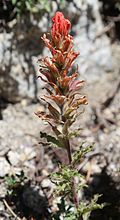 |
Castilleja applegatei | Applegate's Indian paintbrush, wavyleaf Indian paintbrush |
| Castilleja aquariensis | Aquarius Plateau Indian paintbrush | |
 |
Castilleja arachnoidea | Cobwebby Indian paintbrush |
 |
Castilleja arvensis | Field Indian paintbrush |
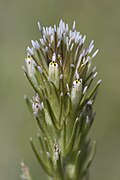 |
Castilleja attenuata | Narrowleaf owl's clover |
| Castilleja beldingii | ||
 |
Castilleja bella | Arteaga Indian paintbrush |
 |
Castilleja brevistyla | |
 |
Castilleja campestris | vernal pool Indian paintbrush |
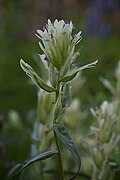 |
Castilleja caudata | Port Clarence Indian paintbrush |
| Castilleja cervina | Deer Indian paintbrush | |
 |
Castilleja christii | Christ's Indian paintbrush |
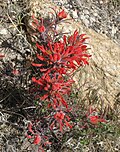 |
Castilleja chromosa | Desert Indian paintbrush, desert paintbrush |
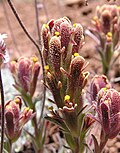 |
Castilleja cinerea | Ashgray Indian paintbrush |
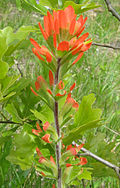 |
Castilleja coccinea | Scarlet Indian paintbrush, Scarlet painted-cup |
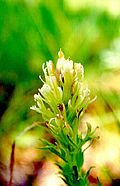 |
Castilleja cusickii | Cusick's Indian paintbrush |
 |
Castilleja densiflora | |
| Castilleja ecuadorensis | ||
| Castilleja elata | ||
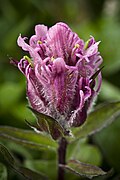 |
Castilleja elegans | Elegant Indian paintbrush |
 |
Castilleja elmeri | Elmer's Indian paintbrush |
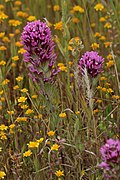 |
Castilleja exserta | Purple owl's clover, purple Indian paintbrush, exserted Indian paintbrush, escobita, formerly in Orthocarpus |
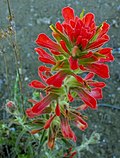 |
Castilleja foliolosa | Texas Indian paintbrush[12] |
| Castilleja fruticosa | ||
| Castilleja fulva | Elko Indian paintbrush | |
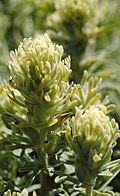 |
Castilleja grisea | |
| Castilleja guadalupensis | (extinct) | |
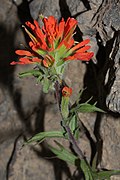 |
Castilleja hispida | Harsh Indian paintbrush |
| Castilleja hyetophila | Coastal red Indian paintbrush | |
| Castilleja hyperborea | Northern Indian paintbrush | |
 |
Castilleja indivisa | Entireleaf Indian paintbrush, Texas paintbrush |
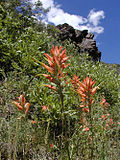 |
Castilleja integra | Wholeleaf Indian paintbrush |
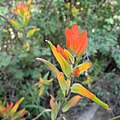 |
Castilleja integrifolia | |
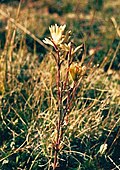 |
Castilleja kaibabensis | Kaibab Indian paintbrush |
| Castilleja kerryana | ||
| Castilleja lacera | ||
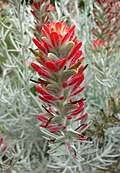 |
Castilleja lanata | Sierra woolly Indian paintbrush |
| Castilleja lasiorhyncha | ||
 |
Castilleja latifolia | |
| Castilleja lauta | Rosy paintbrush | |
 |
Castilleja lemmonii | Lemmon's Indian paintbrush |
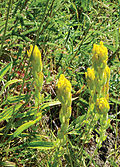 |
Castilleja levisecta | Golden paintbrush |
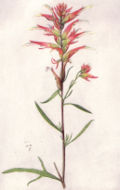 |
Castilleja linariifolia | Narrowleaf Indian paintbrush |
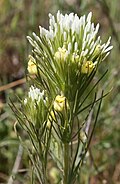 |
Castilleja lineariiloba | |
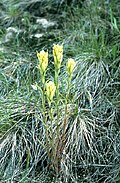 |
Castilleja lutescens | Stiff yellow Indian paintbrush |
 |
Castilleja mendocinensis | |
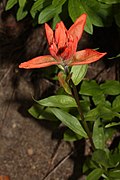 |
Castilleja miniata | Greater red Indian paintbrush |
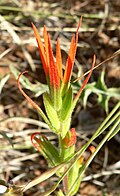 |
Castilleja minor | Smallflower Indian paintbrush, lesser Indian paintbrush |
 |
Castilleja mollis | Softleaf Indian paintbrush |
| Castilleja mutis | ||
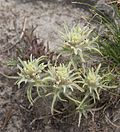 |
Castilleja nana | Alpine paintbrush |
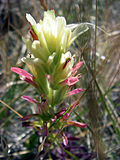 |
Castilleja neglecta | Tiburon Indian paintbrush |
| Castilleja nubigena | ||
 |
Castilleja occidentalis | Western Indian paintbrush |
| Castilleja ophiocephala | ||
 |
Castilleja pallescens | Pallid Indian paintbrush |
 |
Castilleja pallida var. lapponica | Boreal Indian paintbrush |
| Castilleja paramensis | ||
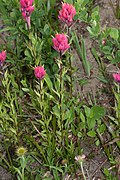 |
Castilleja parviflora | Small-flowered Indian paintbrush |
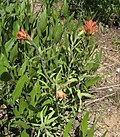 |
Castilleja parvula | |
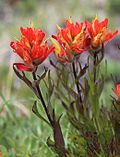 |
Castilleja peirsonii | Peirson's paintbrush |
| Castilleja pilosa | ||
| Castilleja plagiotoma | Mojave Indian paintbrush | |
| Castilleja praeterita | ||
 |
Castilleja pruinosa | |
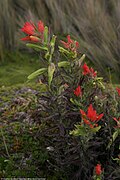 |
Castilleja pumila | Lancetilla del Páramo |
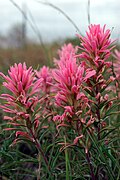 |
Castilleja purpurea | |
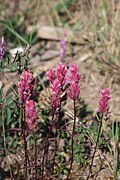 |
Castilleja raupii | Raup's Indian paintbrush, Raup's painted-cup |
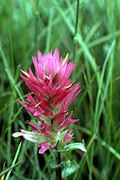 |
Castilleja rhexiifolia | Rhexia-leaf Indian paintbrush, splitleaf Indian paintbrush |
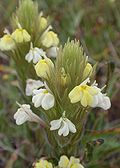 |
Castilleja rubicundula | Cream sacs |
| Castilleja rubida | Purple alpine paintbrush, Wallowa alpine paintbrush | |
 |
Castilleja rupicola | Cliff Indian paintbrush |
| Castilleja salsuginosa | Monte Neva Indian paintbrush | |
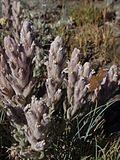 |
Castilleja schizotricha | |
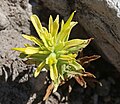 |
Castilleja septentrionalis | Labrador Indian paintbrush, northern paintbrush |
 |
Castilleja sessiliflora | Downy Indian paintbrush, downy paintbrush |
| Castilleja socorrensis | ||
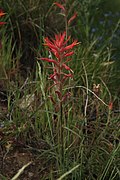 |
Castilleja subinclusa | |
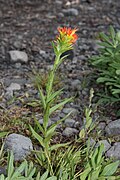 |
Castilleja suksdorfii | Suksdorf's Indian paintbrush |
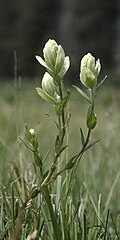 |
Castilleja sulphurea | Sulphur Indian paintbrush |
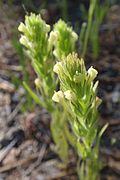 |
Castilleja tenuis | Hairy owl's clover |
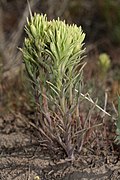 |
Castilleja thompsonii | Thompson's Indian paintbrush |
 |
Castilleja tolucensis | |
 |
Castilleja unalaschcensis | Alaska Indian paintbrush |
 |
Castilleja wightii | Wight's paintbrush |
| Castilleja yukonis | Yukon Indian paintbrush |
References
- ^ "Genus: Castilleja Mutis ex L. f." Germplasm Resources Information Network. United States Department of Agriculture. 2006-03-30. Archived from the original on 2009-05-06. Retrieved 2010-10-22.
- ^ Quattrocchi, Umberto (2000). CRC World Dictionary of Plant Names. Vol. I: A-C. CRC Press. p. 455. ISBN 978-0-8493-2675-2.
- ^ a b c Haan, Nate L.; Bakker, Jonathan D.; Bowers, M. Deane (14 January 2021). "Preference, performance, and chemical defense in an endangered butterfly using novel and ancestral host plants". Scientific Reports. 11 (992): 992. Bibcode:2021NatSR..11..992H. doi:10.1038/s41598-020-80413-y. PMC 7809109. PMID 33446768.
- ^ a b c Haan, Nate L.; Bakker, Jonathan D.; Bowers, M. Deane (May 2018). "Hemiparasites can transmit indirect effects from their host plants to herbivores". Ecology. 99 (2): 399–410. doi:10.1002/ecy.2087. JSTOR 26624251. PMID 29131311. Retrieved 2022-05-02.
- ^ Benda, Christopher. "Indian Paintbrush (Castilleja coccinea)". www.fs.fed.us. United States Department of Agriculture.
- ^ Schmidt, Natalie (2016). Parasitic plants and community composition: how Castilleja levisecta affects, and is affected by, its community (PDF) (Doctoral dissertation). University of Washington. Retrieved 2022-05-02.
- ^ Babikova, Zdenka; Gilbert, Lucy; Bruce, Toby; Dewhirst, Sarah; Pickett, John A.; Johnson, David (April 2014). "Arbuscular mycorrhizal fungi and aphids interact by changing host plant quality and volatile emission". American Journal of Botany. 99 (12). JSTOR 23321298. Retrieved 2022-05-02.
- ^ a b Strategy and Guidance for Minimizing Hybridization Risk of Castilleja levisecta (CALE) with Castilleja hispida (CAHI) While Advancing Conservation of CALE and Taylor's Checkerspot Butterfly (Euphydryas editha taylori; TCB) (PDF) (Report). U.S. Fish and Wildlife Service, Washington Department of Fish and Wildlife, and Washington Department of Natural Resources. 2021. Retrieved 2022-05-02.
- ^ Loretta Fisher; Jonathan D. Bakker; Peter W. Dunwiddie (2015). An Assessment of Seed Production and Viability of Putative Castilleja levisecta × C. hispida Hybrids (Report). Center for Natural Lands Management and University of Washington. doi:10.13140/RG.2.1.4327.2081. Retrieved 2022-05-02.
- ^ Tilford, Gregory L. (1997). Edible and Medicinal Plants of the West. Mountain Press Publishing. pp. 82–83. ISBN 978-0-87842-359-0.
- ^ Wyoming Statute 8-3-104 (Title 8) Archived 2008-05-11 at the Wayback Machine
- ^ "PLANTS Profile for Castilleja foliolosa (Texas Indian paintbrush)". United States Department of Agriculture. Retrieved March 9, 2013.
Further reading
External links
- Native Plant Information Network[permanent dead link]: Listing of species in the Castilleja genus.
- Jepson Manual - taxonomic description of the genus.
- Extensive Castilleja species gallery by Mark Egger
